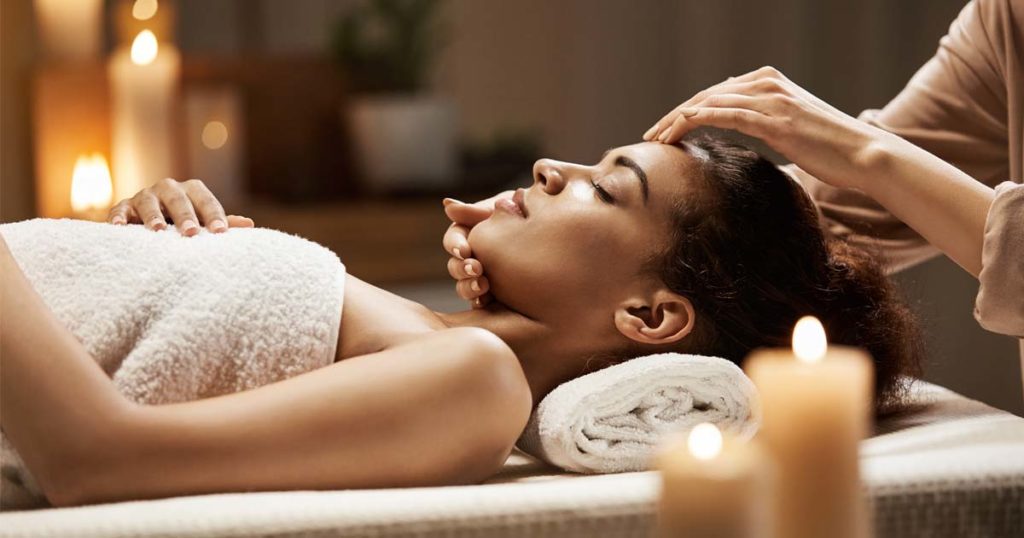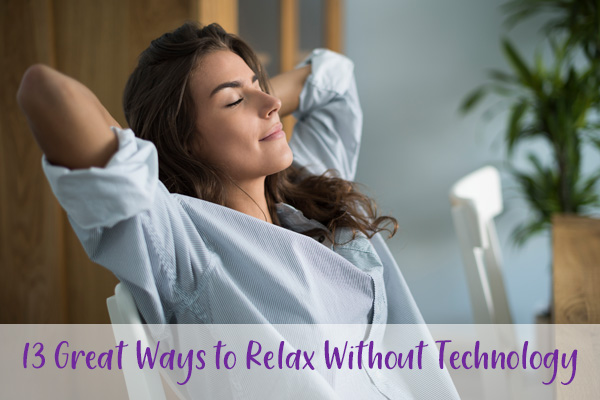We all know how important technology is in our daily lives. Checking up with social media, checking your personal or work email, or even just browsing the internet on your phone can add a lot of stressors to your day. Even when you put all of the technology down the impacts of what you see can stay with you for some time.
Let’s go over some fun and exciting activities so you can put the phone down and learn how to relax without technology.
- Why is Learning How To Relax Without Technology Important
- How to Actually Relax Without Technology
- 1. Meditate
- 2. Take a Hot Bath
- 3. Go For a Walk or Run
- 4. Take Deep Breaths
- 5. Get a Massage
- 6. Spending time with Friends
- 7. Write in a Gratitude Journal
- 8. It’s Yoga Time!
- 9. Paint or Draw – Even if You Don’t Think You’re an Artist
- 10. Visit a Museum
- 11. Look at Some Old Photo Albums and Pictures
- 12. Progressive Muscle Relaxation
- 13. Bake or Cook Something Yummy
- Conclusion
Why is Learning How To Relax Without Technology Important
It is very important to put the phone down and learn how to relax without technology. Technology can be overwhelming and a constant cause of brain stimulation that can lead to feelings of anxiety and stress. Taking a break from technology can help to reduce these feelings and promote a sense of calmness where you can relax and be happy.
Technology can also be addictive. Excessive use of technology can lead to problems such as insomnia, headaches, and eye strain. By taking a break from technology, you can give your body and mind a chance to rest and recover. It can also be a source of distraction and can prevent you from being fully present in the moment. Relaxing without technology can help you to focus on the present moment and enjoy other activities such as reading, talking to friends and family, or being in nature.
One of the things we don’t often discuss, even if others are around, is how isolating technology can be. Even if others are around sometimes we get lost in our phone, computer, TV, or one of our other many screens. This can prevent you from building and maintaining social connections. Relaxing without technology can help you to connect with others in a more meaningful way. Relaxing without technology can be a way to disconnect from the constant stream of news, notifications, and messages, and allow you to focus on yourself, your thoughts and feelings.
Overall, learning how to relax without technology is important for both physical and mental well-being. It can help you to reduce stress, improve mood, and be happier.
How to Actually Relax Without Technology
1. Meditate
Meditation can help you relax by reducing stress and anxiety, slowing down your heart rate and breathing, and decreasing muscle tension. It can also help to improve focus and concentration, and promote a sense of calm and inner peace. Additionally, meditation can help to improve overall well-being and promote relaxation by encouraging mindfulness, the ability to be present in the moment, and allowing the mind to let go of distracting thoughts and emotions. Regular practice of meditation can also lead to long-term changes in the brain that make it easier to relax and cope with stress.
2. Take a Hot Bath
Water and electricity don’t mix so it’s a good thing to leave the technology out of this one. Taking a hot bath can help you relax by increasing blood flow and warming the body, which can lead to physical relaxation and a decrease in muscle tension. The heat from the bath can also help to promote the release of endorphins, which are chemicals in the brain that act as natural painkillers and mood elevators. The warm water can also help to soothe sore muscles and ease stiffness.
Additionally, the ritual of taking a bath, including taking a bubble bath or adding essential oils, can create a sense of comfort, and can also help relax your mind and body from anxiety by promoting mindfulness and allowing the mind to let go of distracting thoughts and emotions. The sound of running water is a generally soothing sound, and when the water is off a bathroom is a quiet place to be. This also helps relax your mind from stress. If you have a dimmer on your lights it will also help to dim the lights in the room. If not, try using some LED candles instead. This will help reduce visual stimulation to help you further relax and be happy.
3. Go For a Walk or Run
Now when you do this, make sure you don’t bring any music along with you or you’re not actually tech-free. Walking can help you relax by reducing stress and anxiety, improving your mood, and increasing the release of endorphins. Additionally, being in nature and getting some fresh air can also help to improve overall well-being and promote relaxation.
If you’re a runner, the physical exertion and distraction of running can take your mind off of any stressors and promote a sense of calm and well-being.
4. Take Deep Breaths
OK, I know you are already breathing. But seriously, taking deep breaths can help. Deep breathing can help with relaxation by activating the body’s relaxation response. This response is a state of rest that is the opposite of the fight-or-flight response, which is activated in times of stress or danger.
When you take deep breaths, you send a message to your brain to calm down and relax. The brain then sends this message to your body to slow down your heart rate, lower your blood pressure, and reduce muscle tension. Deep breathing also increases the amount of oxygen in your body, which can help you improve your overall well-being and promote relaxation. Lastly, deep breathing can also be used as a form of mindfulness practice which can help to clear and relax your mind and reduce stress and anxiety.
5. Get a Massage
A massage is a great way to help you relax without technology, and there are a lot of different massage options if you have any specific stresses to focus on. Even if it’s a face or scalp massage. Like other methods on ways to relax without technology a massage relaxes you by promoting physical relaxation and a decrease in muscle tension.
But a massage takes things a step further. Massages also increase blood flow, which can help to nourish and oxygenate the muscles, and promote the removal of waste products in your bodies system such as lactic acid. The sensation of touch can also have a calming effect, and can help to create a sense of calm, comfort, and relaxation. Regular massages can also help to improve sleep quality and overall well-being.

6. Spending time with Friends
Spending time with friends can help you relax and be happy in a few different ways. First, being around people you care about and who care about you can provide a sense of social support and validation, which can help reduce stress and improve your mood. Engaging in social activities with friends can also provide a sense of distraction which can take your mind off of any stressors you may be experiencing. Laughing and having fun with friends is a great way to relax without technology as long as you can all agree to keep your phones down.
7. Write in a Gratitude Journal
Writing in a gratitude journal can help you relax by shifting your focus to the positive aspects of your life. In my opinion, writing in a journal is one of the best ways to relax at home. When you’re feeling stressed or overwhelmed, it can be easy to get caught up in negative thoughts and feelings we all experience in our daily lives. By taking the time to write down things that you’re grateful for you can shift your attention to the good things in your life. Doing this can help put things in perspective and reduce feelings of stress and anxiety. Additionally, focusing on the positive aspects of your life can help improve your overall mood, and make you feel more relaxed without technology.
8. It’s Yoga Time!
Yoga can help you relax by promoting both physical and mental relaxation. Physically, yoga involves a series of postures, or asanas, that can help to release tension in the body and improve flexibility which can help reduce muscle tension and pain. Yoga also includes breathing exercises, or pranayama, which can help to regulate the breath and promote a sense of calm and relaxation. Mentally, yoga promotes relaxation through mindfulness and meditation, which can help to relax your mind and body from anxiety and depression. The combination of physical and mental practice can help to create a relaxed state of body and mind.
9. Paint or Draw – Even if You Don’t Think You’re an Artist
Painting or drawing has a number of positive affects on your mental state helping you to relax without technology. First, the act of creating art can be very therapeutic and can provide a sense of accomplishment and satisfaction. Additionally, painting allows you to express yourself creatively which can be a powerful way to release emotions and stress.
The process of painting requires focus and concentration which can help to distract your mind from any stressors promoting a sense of calmness. Painting can also be a meditative experience, where you can get lost in the process of painting or drawing and forget about the world around you.
Additionally, colors have a psychological effect, and are known to affect the mood, so choosing colors and working with them can have a therapeutic effect on the mind and body.

10. Visit a Museum
Visiting a museum is a great way to help you take your mind off things and calm your nerves. Viewing art can have a therapeutic effect on the mind because it can evoke emotions and stimulate the imagination which can provide a sense of release and relaxation. Furthermore, the peaceful and calm atmosphere of most museums, can create a sense of tranquility and serenity, which can help to reduce stress and improve overall well-being.
Visiting a museum can also be a great way to learn and gain new a new enlightenment of art and culture which can help to put things in perspective and reduce feelings of stress. If you choose to go with friends and family it can provide a sense of social support, and make for a fun and enjoyable experience.
11. Look at Some Old Photo Albums and Pictures
Looking at old photo albums and pictures will help stimulate your brain similar to a museum, but looking at pictures where you have a personal connection takes the stimulation a step further. It can provide a sense of nostalgia, where you can reminisce about past memories and experiences, which can evoke positive emotions and improve your overall mood. This can also have a therapeutic effect, helping to release any repressed emotions.
Looking at old photo albums can provide a sense of connection to the past and to loved ones who may be no longer with you. It can remind you of shared experiences and happy moments, which can bring comfort and a sense of connection. Old photos can be a peaceful and calming activity. It doesn’t require much effort and it’s a great way to spend quiet time alone or with loved ones where everyone can relax with technology involved. Have fun with your loved ones and bond over all of the shared memories
12. Progressive Muscle Relaxation
Progressive muscle relaxation (PMR) is a technique that helps you to relax by tensing and then releasing different muscle groups in your body. The process involves tensing a muscle group for a few seconds, and then relaxing it for a few seconds to release the tension. By doing this, you can learn to recognize the difference between a tensed muscle and a relaxed muscle, and use this knowledge to help you relax when you’re feeling stressed.
The technique can also help to lower blood pressure and heart rate, which can help to reduce feelings of stress and anxiety. PMR is a simple and effective technique that can be practiced at home, and with regular practice, it can help to reduce stress and improve overall well-being without the use of any technology to help you relax and be happy.
13. Bake or Cook Something Yummy
Cooking is a form of creative expression where you can experiment with different ingredients and flavors to create something new and delicious. This can provide a sense of accomplishment and satisfaction which can improve overall mood.
Whether you’re following a recipe or baking something from scratch it requires you to focus on the present moment and tune out any distractions. The process of chopping, measuring, and mixing ingredients can be calming and soothing, and promote a sense of relaxation.
Cooking is also a multi-sensory experience where the sights, smells, and tastes of the food you’re preparing can be very pleasing and satisfying. The aroma of food cooking can be particularly relaxing, and it can evoke positive memories and emotions.
Lastly, Cooking can be a way to take care of yourself, by preparing healthy and nutritious meals, which can improve overall well-being. When you’re done cooking or baking take your food as an opportunity to spend quality time with family and friends. It can be a fun and enjoyable bonding experience which can provide a sense of social support and connection.
Overall, Cooking can be a great way to unwind and de-stress. It has many benefits for both the mind and body so you can get away from the technology and relax.
Conclusion
Although technology is a vital part of society today it’s also important to take a break from it. All of the screens we use can cause eye strain and headaches. It can also decrease sleep quality because of the exposure to the blue light emitted by screens which can disrupt the body’s natural sleep-wake cycle. These are just some of the reasons why it’s good to learn how to relax without technology.
Taking a break from those screens can help increase productivity by allowing the brain to rest and recharge. Your mental health can also improve by reducing the feelings of anxiety, depression, and loneliness. Taking a break and following some of our ideas on how to spend some time away from your phone will help you to relax and be happy. You’ll be more present and engaged with the world around you leading to a more fulfilling life.

